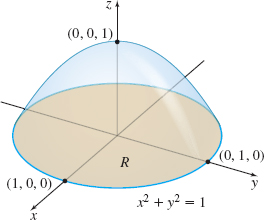EXAMPLE 2Finding Surface Area
Find the surface area of the part of the paraboloid z=f(x,y)=1−x2−y2 that lies above the xy-plane.

Solution Figure 39 shows the part of the surface z=1−x2−y2 that lies above the xy-plane and its projection onto the xy-plane, the region R enclosed by the circle x2+y2=1. We begin by finding the partial derivatives of z=f(x,y). fx(x,y)=−2xfy(x,y)=−2y
Since fx and fy are continuous on R, the surface area S of the part of z=f(x,y)=1−x2−y2 that lies above R is S=∬
Since both the region R (a circle) and the integrand involve x^{2}+y^{2} , we use polar coordinates (r,\theta). For the region R, we have 0\leq r\leq 1 and 0\leq \theta \leq 2\pi. Then \begin{equation*} \begin{array}{rcl} S& =&\displaystyle\iint\limits_{\kern-3ptR}\sqrt{4(x^{2}+y^{2})+1}\,d\!A\underset{\underset{\underset{{\color{#0066A7}{\hbox {\({dx}\, {dy}=r\,{dr} d\theta\)}}}} {\color{#0066A7}{\hbox{\(x^{2}+y^{2}=r^{2}\)}}}} {\color{#0066A7}{\uparrow}}}{=} \int_{0}^{2\pi }\int_{0}^{1}\sqrt{4r^{2}+1}r\,dr\,d\theta \notag \\ &=&\int_{0}^{2\pi }\dfrac{1}{12}\big[ ( 4r^{2}+1) ^{3/2}\big] _{0}^{1}\,d\theta =\dfrac{1}{12}(5\sqrt{5}-1)\int_{0}^{2\pi }\,d\theta = \dfrac{1}{12}(5\sqrt{5}-1)2\pi\\[9pt] &=&\dfrac{\pi }{6}(5\sqrt{5}-1) \end{array} \end{equation*}